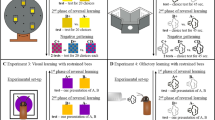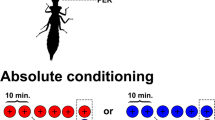Abstract
Most of our knowledge of learning in the hymenoptera with its hundreds of thousands of species is so far restricted to one species, the honey bee. Learning mechanisms in this animal as it may relate to ecological requirements will be discussed. Furthermore, I will explore ecological adaptations of behavior and learning drawn from the literature and make predictions about the types of learning expected in some other hymenoptera that face entirely different learning problems than those faced by honey bees. Finally, I suggest that a comparative approach to a study of learning in the hymenoptera may enlarge our insights into constraints in the biology of learning.
Access this chapter
Tax calculation will be finalised at checkout
Purchases are for personal use only
Preview
Unable to display preview. Download preview PDF.
Similar content being viewed by others
References
Alloway, T.M. 1969. Effect of low temperature upon acquisition and retention in the grain beetle (Tenebrio molitor). J. Comp. Physiol. Psychol. 69: 1–8.
Breed, M.D. 1981. Individual recognition and learning of queen odors by worker honey bees. Proc. Natl. Acad. Sci. USA 78: 2635–2637.
Dyer, F.C., and Gould, J.L. 1981. Honey bee orientation: A backdrop system for cloudy days. Science 214: 1041–1042.
Erber, J. 1976. Retrograde amnesia in honey bees (Apis mellifera carnica). J. Comp. Physiol. Psychol. 90: 41–46.
Erber, J. 1982. Movement learning of free flying honey bees. J. Comp. Physiol. A 146: 273–282.
Erber, J.; Masuhr, T.; and Menzel, R. 1980. Localization of short-term memory in the brain of the bee, Apis mellifera. Physiol. Entomol. 5: 343–358.
Heinrich, B. 1975. Thermoregulation in bumblebees II. Energetics of warm-up and free flight. J. Comp. Physiol. 76: 155–166.
Heinrich, B. 1976. The foraging specializations of individual bumblebees. Ecol. Mon. 46: 105–128.
Heinrich, B. 1979. “Majoring” and “Minoring” by foraging bumblebees, Bombus vagans: an experimental analysis. Ecol. 60: 245–255.
Heinrich, B. 1980. Mechanisms of body-temperature regulation in honey bees, Apis mellifera. J. Exp. Biol. 85: 73–87.
Heinrich, B., and Heinrich, M.J. 1983. Strategies of thermoregulation and foraging in two vespid wasps, Dolichovespula masculata and Vespula vulgaris. J. Comp. Physiol. B, in press.
Heinrich, B.; Mudge, P.R.; and Deringis, P.A. 1977. Laboratory analysis of flower constancy in foraging bumblebees: Bombus ternarius and B. terricola. B.hay. Ecol. Sociobiol. 2: 247–265.
Koltermann, R. 1973. Rassen-bzw. artspezifische Duftbewertung bei der Honigbiene und ökologische Adaptation. J. Comp. Physiol. 85: 327–360.
Koltermann, R. 1974. Periodicity in the activity and learning performance of the honey bee. In Experimental Analysis of Insect Behavior, ed. L. Barton Browne, pp. 218–227. Berlin, Heidelberg, New York: Springer Verlag.
Laverty, L.M. 1980. The flower-visiting behavior of bumblebees; floral complexity and learning. Can. J. Zool. 58: 1324–1335.
Lindauer, M. 1960. Time compensated sun orientation in bees. Cold Spring Harbor Symp. Q. Biol. 25: 371–377.
MacSwain, J.W.; Raven, P.H.; and Thorpe, R.W. 1973. Comparative behavior of bees and Onagraceae. IV. Clarkia bees of the Western United States. Univ. Calif. Publ. Ent. 70: 1–80.
Martin, V.; Martin, H.; and Lindauer, M. 1978. Transplantation of a time-signal in honey bees. J. Comp. Physiol. A 124: 193–201.
Meineke, H. 1978. Umlernen in der Honigbiene zwischen Gelb-und Blau-belohnung im Dauerversuch. J. Insect Physiol. 24: 155–163.
Menzel, R. 1968. Das Gedächtnis der Honigbiene für Spektralfarben. Z. vergl. Physiol. 60: 82–102.
Menzel, R. 1979. Behavioral access to short-term memory in bees. Nature 281: 368–369.
Menzel, R.; Erber, J.; and Masuhr, T. 1974. Learning and memory in the honey bee. In Experimental Analysis of Insect Behavior, ed. L. Barton Browne, pp. 195–217. Berlin, Heidelberg, New York: Springer Verlag.
Nye, W.P., and Mackenson, O. 1968. Selective breeding of honey bees for alfalfa pollen: fifth generation and backcrosses. J. Apic. Res. 7: 21–27.
Oelsen, von G., and Rademacher, E. 1979. Untersuchungen zum Bauverhalten der Honigbiene (Apis mellifera). Apidol. 10: 175–209.
Pesotti, I. 1972. Dissemination with light stimuli and lever pressing responses in Melipona rufiventris. J. Apic. Res. 11: 89–93.
Reinhardt, J.F. 1952. Some responses of honey bees to alfalfa flowers. Naturalist 86: 257–275.
Rothenbuhler, W.C. 1964. Behavioral genetics of nest cleaning in honey bees. I. Responses of four inbred lines to disease-killed brood. Anim. Behay. 12: 578–583.
Strickler, K. 1979. Specialization and foraging efficiency of solitary bees. Ecol. 60: 998–1009.
Waddington, K.D.; Allen, T.; and Heinrich, B. 1981. Floral preferences of bumblebees (Bombus edwardsii) in relation to intermittent versus continuous rewards. Anim. Behay. 29: 779–784.
Weaver, N. 1957. The foraging behavior of bees on hairy vetch. Insectes Sociaux 4: 43–57.
Author information
Authors and Affiliations
Editor information
Rights and permissions
Copyright information
© 1984 Berlin, Heildelberg, New York, Tokyo: Springer-Verlag
About this paper
Cite this paper
Heinrich, B. (1984). Learning in Invertebrates. In: Marler, P., Terrace, H.S. (eds) The Biology of Learning. Dahlem Workshop Reports, vol 29. Springer, Berlin, Heidelberg. https://doi.org/10.1007/978-3-642-70094-1_7
Download citation
DOI: https://doi.org/10.1007/978-3-642-70094-1_7
Publisher Name: Springer, Berlin, Heidelberg
Print ISBN: 978-3-642-70096-5
Online ISBN: 978-3-642-70094-1
eBook Packages: Springer Book Archive




